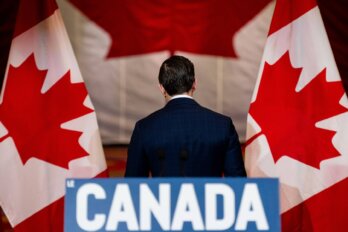This election, the biggest issue for many voters is how the government will tackle affordability. Expectations are high for immediate and tangible relief to Canadians’ wallets.
The parties know this. Both Conservative Party leader Pierre Poilievre and Prime Minister Mark Carney have promised a tax cut to the lowest income bracket. Poilievre promised a cut of 2.25 percentage points, which would reduce the tax on that tax bracket from 15 percent to 12.75 percent, while Carney pledged a one percentage point cut from 15 to 14 percent.
What that translates to, according to the Conservatives’ messaging, is that two-income families would save $1,800 a year, and people earning $57,375 a year or less would see savings of $900. The Liberals say their tax cut would save two-income families up to $825 a year, which would benefit 22 million Canadians, mostly from middle- and low-income backgrounds. The median total income for an individual in 2022 was $41,900.
As far as campaign promises go, tax cuts are not new. In 1993, when the federal Liberals were the official opposition, then leader Jean Chrétien campaigned on the public dislike of the Goods and Services Tax, promising to kill it if his party formed the next government. The Liberals swept into a majority, but as we know now, they never scrapped the GST. In 2006, the Conservative government under then prime minister Stephen Harper did cut it by one percentage point to 6 percent, followed by another reduction to 5 percent in 2008.
Politicians are fixated on tax cuts, says Mauricio Zelaya, Ernst and Young Canada partner and national economics leader, because while economic and productivity issues can be complicated to explain during a campaign, “if you just say, ‘Hey, tax cuts,’” people understand that. Zelaya points out that tax cuts are inherently progressive, meaning they’re not exclusive to the lowest income bracket. “Even if you’re a high-income earner, your first X amount of dollars will be taxed at a certain rate, and if that gets reduced, then [you] benefit from it.” While such cuts benefit people across income brackets, wealthier individuals often benefit more.
Lars Osberg, professor of economics at Dalhousie University, says that one reason tax cut promises are so potent is that people are often convinced their self-interest is also in society’s interest. “A lot of us are people who actually are selfish bastards who can talk themselves into the idea that, ‘Oh, if you cut my taxes, that will produce growth in the economy, and it’ll be wonderful for everybody,’” he says. “So the distinction between what’s good for yourself and what’s good for society isn’t absolutely clear cut.”
Zelaya points out that if whichever party forms government does cut taxes, the money would have to come from somewhere else, requiring other revenue options. Right now, we don’t know what those might look like until after the election.
At the same time, voters often believe they can get something for nothing, or what Osberg calls “tooth fairy economics.”
“By tooth fairy economics, I mean when my oldest boy was seven years old, and we went to look under his pillow, there was a tooth and there was a little note that said, ‘Dear tooth fairy, can I have the money and keep the tooth too?’” Osberg says. “[Tax cuts are] advertised as a freebie, as something that reduces the cost of living without having any other consequences,” he says, such as possible cuts to federal programs. “It’s kind of genius marketing to take the affordability agenda and turn it into a tax cut agenda, because rich people can afford what they want.”
All parties are promising cuts of some kind. The New Democratic Party, which has not promised an income tax cut, says it would raise the basic personal amount (BPA)—the minimum level below which people don’t have to pay federal income tax—from $16,129 to $19,500. The Greens are promising to raise the BPA to $40,000. The Bloc Québécois have focused their efforts on increasing the Old Age Security pension for those aged sixty-five to seventy-four by 10 percent, removing GST on second-hand goods, and increasing the working income exemption for the Guaranteed Income Supplement.
Another consistent theme is that most, if not all, parties are focused on improving the finances of the “middle class”—a concept that many people either understand or relate to. “It’s what we almost think of as a representative Canadian,” says Zelaya.
In 2019, the Organisation for Economic Co-operation and Development defined members of the middle class as those who earn between 75 and 200 percent of the median household income. That’s anywhere between $52,875 to $141,000, according to Statistics Canada, given that the median after-tax income for families and unattached individuals in 2022 was $70,500.
Osberg says that over the past thirty years, fewer Canadians and Americans identify as middle class, with more now seeing themselves as working class or lower middle class. “That reflects adaptation into a long period of income stagnancy for people in the lower middle part of the income distribution,” he says. “But old habits die hard, and aspirations to join the middle class are certainly still there.”
Politically and socially, invoking the middle class is effective, as it includes those who are in the middle of the income distribution and those who aspire to be, which covers the majority of Canadians. But fixating on the middle class also means that there’s a reluctance to talk directly about poverty. “If you’re worried about homelessness, or you’re worried about poverty, you don’t want to admit that to yourself,” says Osberg. “You want to look at the positives rather than the negatives. So the policies that would really directly address the economic insecurity that many people feel become a bit stigmatized.”
In a 2019 article for the CBC, business columnist Don Pittis pointed out that political parties typically don’t address poverty in their election campaigns because those most affected by it aren’t seen as a significant voter base.
Both Osberg and Zelaya acknowledge that if the core goal of a tax cut is to put more money in people’s pockets, there are better options. Osberg suggests focusing on policies like the Canada Child Benefit or the Guaranteed Income Supplement for seniors, while Zelaya suggests that the government could instead tackle the underlying cost pressures, which includes building more homes, a promise both leading parties have also made.
Debates around tax cuts “all swirl above fundamental moral foundations,” says Kelly Peters, behavioural economist leader and partner at Deloitte. Moral foundations are built around what people think is important to protect and what they believe will lead to a better and healthier society, she says. “Once you know your first principles, then it becomes easy for you to adhere to policy that is consistent with [them], and to have a logic around it.”
But “before we bring logic, [we] identify with a political party,” she says. That’s why voters often interpret political messages through the lens of partisan identity.
The question voters might want to ask themselves this election is whether tax cuts truly offer affordability or if they simply sound like they do. This election, in other words, shouldn’t be about picking the tax cut that feels right, but about recognizing whether those cuts are really what we need.





